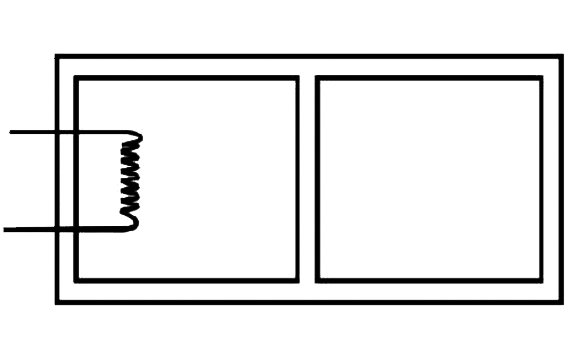If CpandCv denoted the specific heats of unit mass of nitrogen at constant pressure and volume respectively, then Solution in Gujrati
CP−CV=R/28
CP−CV=R/14
CP−CV=R
CP−CV=28R
The correct Answer is:A
We have , molar heat capacity = molar mass × specific heat capacity per unit mass
∴CP=28CP(for nitrogen )andCV=28CV
Now CP−CV=Ror28CP−28CV=R
⇒CP−CV=R28
Topper's Solved these Questions
- GEOMETRICAL OPTICSBOOK - ALLEN CHAPTER - GEOMETRICAL OPTICSEXERCISE - EXERCISE - 05 (B)
58 Videos
- GEOMETRICAL OPTICSBOOK - ALLEN CHAPTER - GEOMETRICAL OPTICSEXERCISE - EXERCISE - 05 (B) (MCQ)
9 Videos
- GEOMETRICAL OPTICSBOOK - ALLEN CHAPTER - GEOMETRICAL OPTICSEXERCISE - EXERCISE - 04 (B)
15 Videos
- CURRENT ELECTRICITYBOOK - ALLEN CHAPTER - CURRENT ELECTRICITYEXERCISE - EX.II
66 Videos
- GRAVITATIONBOOK - ALLEN CHAPTER - GRAVITATIONEXERCISE - EXERCISE 4
9 Videos
Similar Questions
A vessel contains a mixture of one mole of oxygen and two moles of nitrogen at 300K. The ratio of the average rorational kinetic energy per O2 molecules to that per N2 molecules is
View SolutionLet ¯v,vrms and vp respectively denote the mean speed, the root-mean - square speed, and the most probable speed of the molecules in an ideal monoatomic gas at absolute temperature T. The mass of a molecule is m:-
View SolutionThe rectangular box shown in Fig has partition which can slide without friction along the length of the box. Initially each of the two chambers of the box has one mole of a mono-atomic ideal gas (λ=5/3) at a pressure P0, volume V0 and temperature T0. The chamber on the left is slowly heated by an electric heater. The walls of the box and the lead wires of the heater is negligible. The gas in the left chamber expands pushing the partition until the final pressure in both chambers becomes 243P0/32. Determine (i) the final temperature of the gas in each chamber and (ii) the work done by the gas in the right chamber.

View SolutionIn the Bohr's model of hy drogen atom, the electron moves around the nucleus in a circular orbit of radius 5×10−11m. Its time period is 1.5×10−16s. The current associated with the electron motion is:-
View SolutionAssertion : The difference in the value of acceleration due to gravity at pole and equator is proportional to square of angular velocity of earth.
Reason : the value of acceleration due to gravity is minimum at the equator and maximum at the pole.
View SolutionIf for hydrogen C_(P) - C_(V) = m and for nitrogen C_(P) - C_(V) = n , where C_(P) and C_(V) refer to specific heats per unit mass respectively at constant pressure and constant volume, the relation between m and n is (molecular weight of hydrogen = 2 and molecular weight or nitrogen = 14)
View SolutionCvandCp denote the molar specific heat capacities of a gas at constant volume and constant pressure, respectively. Then
View SolutionIf C_(p) and C_(v) denoted the specific heats of unit mass of nitrogen at constant pressure and volume respectively, then
View Solutionयदि नाइट्रोजन के एकांक द्रव्यमान के लिए नियत दाब और नियत आयतन पर विशिष्ट ऊष्मा धारिताएँ क्रमशः Cp और Cvहै तो -
View SolutionC_(v) and C_(p) denote the molar specific heat capacities of a gas at constant volume and constant volume and constant pressure, respectively. Then,
View SolutionIf CpandCv denote the specific heats of nitrogen per unit mass at constant pressure and constant volume respectively, then
View SolutionCpandCv denote the molar specific heat capacities of a gas at constant volume and constant pressure respectively. Then
View SolutionIf CPandCV denote the specific heats of nitrogen per unit mass at constant pressure and constant volume respectively then
View SolutionIf CPandCV denote the specific heats of nitrogen per unit mass at constant pressure and constant volume respectively then
View SolutionIf CpandCv denoted the specific heats of unit mass of nitrogen at constant pressure and volume respectively, then
View Solutionयदि CP एवं CV क्रमशः नियत दाब एवं आयतन पर नाइट्रोजन के इकाई द्रव्यमान की विशिष्ट उष्माओं को दर्शाता हैं , तो
View Solution
